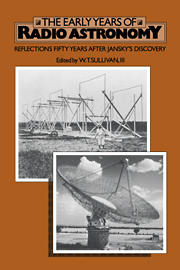Book contents
- Frontmatter
- Contents
- Preface
- THE EARLIEST YEARS
- AUSTRALIA
- The origins of radio astronomy in Australia
- The first decade of solar radio astronomy in Australia
- Early days in radio and radar astronomy in Australia
- Radio sources and the log N–log S controversy
- Early work on imaging theory in radio astronomy
- ENGLAND
- THE REST OF THE WORLD
- BROADER REFLECTIONS
- Biographical notes on contributors
- Name index
- Subject index
The origins of radio astronomy in Australia
Published online by Cambridge University Press: 05 March 2010
- Frontmatter
- Contents
- Preface
- THE EARLIEST YEARS
- AUSTRALIA
- The origins of radio astronomy in Australia
- The first decade of solar radio astronomy in Australia
- Early days in radio and radar astronomy in Australia
- Radio sources and the log N–log S controversy
- Early work on imaging theory in radio astronomy
- ENGLAND
- THE REST OF THE WORLD
- BROADER REFLECTIONS
- Biographical notes on contributors
- Name index
- Subject index
Summary
THE IMMEDIATE POST-WAR ACTIVITIES OF THE DIVISION OF RADIOPHYSICS
Radio astronomy began in Australia at the Division of Radiophysics of CSIR (Council for Scientific and Industrial Research, later renamed CSIRO, Commonwealth Scientific and Industrial Research Organization) as a direct outcome of its involvement in radar research and development during World War II. The Division was established in 1939 with responsibility for developing radar for the Australian Army, Navy and Air Force – and later for the American Forces in the Southwest Pacific. What were the ingredients which led in 1946 to the development of radio astronomy?
The first and by far the most important of these was the decision by the Chairman of CSIR, Sir David Rivett, that at the conclusion of World War II, CSIR would be devoted only to peace-time research, and that defence research would be carried out by other agencies. This meant that a highly developed laboratory with a superlative staff became available for a wide range of researches and practical developments in a peace-time environment.
It would be easy to underestimate the importance of this decision. In later years we were to be reminded of its wisdom by the fate of some overseas laboratories which were not so fortunate. For many years they carried joint responsibility for civilian and military research. When a new research proposal came up, it often led to a bureaucratic argument as to whether it was predominantly civilian or military – and what priority it should be given. This argument would run right down through the staff structure, to the detriment of the job itself.
- Type
- Chapter
- Information
- The Early Years of Radio AstronomyReflections Fifty Years after Jansky's Discovery, pp. 85 - 112Publisher: Cambridge University PressPrint publication year: 1984
- 12
- Cited by

